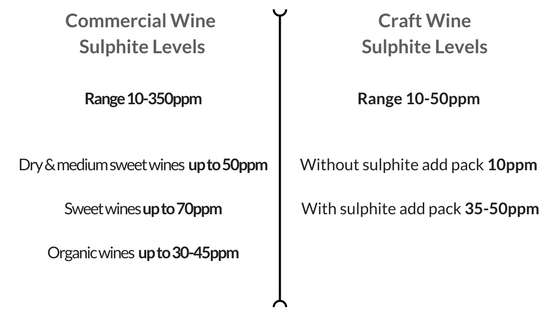Less Sulphites in Craft Produced Wine
What are sulphites? Are they good or bad? Learn everything you need to know about this chemical compound.

Contains Sulphites. These are words you see on almost every commercial bottle of wine, but so many do not understand what this means. Danny's Wine and Beer Supplies will get to the bottom of sulphites in wine, compare commercial wine sulphite levels to craft wine, discuss how you can reduce them when crafting your own wine, and provide tips for storage and consumption.
What Are Sulphites?
Sulphur dioxide (or SO2) is a chemical compound made up of sulfur and oxygen. It occurs naturally but can also be produced in a laboratory. It’s used to preserve foods and beverages, which it does by acting as an antioxidant and antimicrobial.
Sulphites in Wine
Sulphur dioxide has been used in winemaking for thousands of years, ever since the ancient Romans discovered that it would keep their wine from turning into vinegar. To this day sulphites play an important role in preventing oxidization and maintaining a wine’s freshness. They also help in the extraction of pigments in wine, making red wines “redder.”
The sulphite level in wine is measured in “ppm”, or parts per million. In Canada and the United States, conventionally made wines are permitted to contain up to 350ppm of sulphites, and in the European Union wine may contain up to 210 ppm sulphites. The current CFIA labelling requirements for Alcoholic Beverages requires any wine that contains more than 10 ppm (parts per million) sulphite to be labeled with, “Contains sulphites.”
Are Sulphites in Wine Bad?
Not for most people. There are however some notable exceptions to this rule. About 5-10% of people with asthma have severe sulphite sensitivity. Sulfur is also on the rise as a concern among the populous as a cause of health problems (from migraines to body swelling), because of its prevalence in processed foods.
Reducing Sulphites in Your Craft Wine
One of the many unique benefits of crafting your wine, is that you can customize the wine to your needs – and if reducing the sulphite levels is one of those needs, you’re in luck! If crafting in store, be sure to discuss this with your craft wine retailer and they will assist you with this. If you are crafting at home, you can opt to not add any sulphites to your wine to reduce their level. However, there will still be some present in the final product (10ppm), as it is a natural by-product of fermentation. If you are adding sulphites via the add pack, as per our instruction sheets then the final product will have between 35-50ppm. Ensuring that everything is properly sanitized when crafting your wine and using longer corks to minimize oxidation will help ensure the quality of your wine.
Note: Most retailers will waive their 100% satisfaction guarantee if you opt to omit using the sulphites add pack.
Comparing Craft Wine Sulphites to Commercial Wines
 Storing & Consuming Your Sulphite-Reduced Craft Wine
Storing & Consuming Your Sulphite-Reduced Craft Wine
Craft wines that have been crated without the sulphite add pack should be consumer when they are young, as they are not as protected against bacterial infection and oxidation. We would recommend drinking them within 2 weeks to a maximum of 6 months from their production date. They should be stored in a temperature-controlled environment (less than 16°C/60°F) out of direct light.
Contrary to popular belief, we do not recommend storing your wine in a refrigerator long-term unless it is set to a “cellar” temperature. As when wine is stored at lower temperatures, it could cause a precipitation of tartaric crystals.



Leave a comment